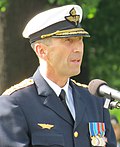| No. | Portrait | Name | Took office | Left office | Time in office | Ref. |
|---|
| Chief of the Air Force (Chefen för flygvapnet, C FV) |
|---|
| 1 | | Amundson, Karl Major general
Karl Amundson
(1873–1938) | 1 July 1926 | 25 February 1931 | 4 years, 239 days | - |
| 2 | | Virgin, EricMajor general
Eric Virgin
(1876–1950) | 26 February 1931 | 30 June 1934 | 3 years, 124 days | - |
| 3 | | Friis, TorstenMajor general
Torsten Friis
(1882–1967) | 1 July 1934 | 30 June 1942 | 7 years, 364 days | - |
| 4 | | Nordenskiöld, Bengt Lieutenant general
Bengt Nordenskiöld
(1891–1983) | 1 July 1942 | 30 June 1954 | 11 years, 364 days | [10] |
| 5 | | Ljungdahl, AxelLieutenant general
Axel Ljungdahl
(1897–1995) | 1 July 1954 | 30 June 1960 | 5 years, 365 days | - |
| 6 | | Rapp, TorstenLieutenant general
Torsten Rapp
(1905–1993) | 1 July 1960 [note 1] | 30 September 1961 | 1 year, 91 days | [11] |
| 7 | | Thunberg, LageLieutenant general
Lage Thunberg
(1905–1977) | 1 October 1961 | 30 September 1968 | 6 years, 273 days | [12] |
| - | | Nordenskiöld, Claës-HenrikMajor general
Claës-Henrik Nordenskiöld
(1917–2003)
Acting | 1 July 1968 | 30 September 1968 | 91 days | - |
| 8 | | Norén, StigLieutenant general
Stig Norén
(1908–1996) | 1 October 1968 | 30 September 1973 | 4 years, 364 days | - |
| 9 | | Stenberg, DickLieutenant general
Dick Stenberg
(1921–2004) | 1 October 1973 | 30 September 1982 | 8 years, 364 days | [13] |
| 10 | | Olson, Sven-OlofLieutenant general
Sven-Olof Olson
(1926–2021) | 1 October 1982 | 30 September 1988 | 5 years, 365 days | [14] |
| 11 | | Englund, Lars-ErikLieutenant general
Lars-Erik Englund
(1934–2010) | 1 October 1988 | 30 June 1994 | 5 years, 272 days | [15] [16] |
| Chief of Air Force Command (Chef för flygvapenledningen, C FVL) |
|---|
| 11 | | Englund, Lars-ErikLieutenant general
Lars-Erik Englund
(1934–2010) | 1 July 1994 | 30 September 1994 | 91 days | [16] |
| 12 | | Harrskog, KentLieutenant general
Kent Harrskog
(born 1944) | 1 October 1994 | 30 June 1998 | 3 years, 364 days | [16] [17] |
| Inspector General of the Air Force (Generalinspektör för flygvapnet, GI FV) |
|---|
| 13 | | Jonsson, JanMajor general
Jan Jonsson
(1952–2021) | 1 July 1998 | 30 June 2000 | 1 year, 365 days | [17] [18] |
| 14 | | Nilsson, MatsMajor general
Mats Nilsson
(born 1956) | 1 July 2000 | 1 December 2002 | 2 years, 153 days | [18] [19] |
| Inspector of the Air Force (Flygvapeninspektör, FVI) |
|---|
| 15 | | Andersson, JanMajor general
Jan Andersson
(born 1955) | 1 January 2003 | 29 February 2008 | 5 years, 59 days | [19] |
| 16 | | Silwer, AndersMajor general
Anders Silwer
(born 1959) | 1 March 2008 | 31 December 2011 | 3 years, 305 days | [20] |
| 17 | | Bydén, MicaelMajor general
Micael Bydén
(born 1964) | 1 January 2012 | 2014 | 1–2 years | [21] |
| Chief of Air Force (Flygvapenchef, FVC) |
|---|
| 17 | | Bydén, MicaelMajor general
Micael Bydén
(born 1964) | 2014 | 30 September 2015 | 0–1 years | - |
| 18 | | Helgesson, MatsMajor general
Mats Helgesson
(born 1964) | 1 October 2015 | 1 October 2019 | 4 years, 0 days | [22] [23] |
| 19 | | Edström, Carl-JohanMajor general
Carl-Johan Edström
(born 1967) | 1 October 2019 | 13 December 2022 | 3 years, 73 days | [23] |
| 20 | | Wikman, JonasMajor general
Jonas Wikman
(born 1972) | 14 December 2022 | Incumbent | 2 years, 218 days | [24] |























